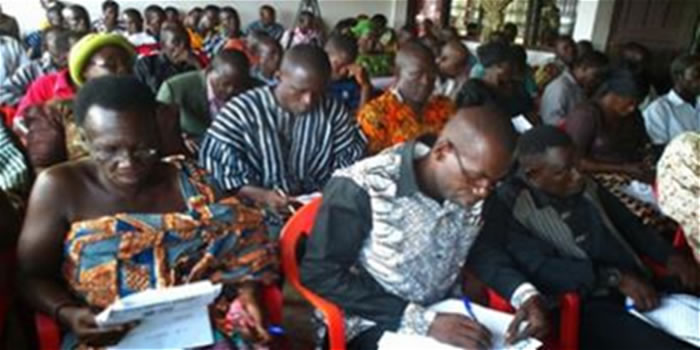

Introduction
Information and communication technology (ICT) development has been in Ghana with a significant growth over the past fifteen years. ICT has brought about social and economic development and transformation by creating an enabling environment for an accelerated economic growth. For the first time in the country, the 2010 Population and Housing Census collected data on access to and use of ICT by individuals and households. This chapter therefore provides information on ownership and access to mobile phones, internet facilities at home, in an internet café, on mobile phone or other devices, household ownership of desktops or laptop computers, and access to fixed telephone lines.
Ownership of Mobile Phones
Internet and mobile phones have become the fastest and easiest means of communicating, accessing and sharing information, financial transactions and accessing health services among others across the globe. Table 5.1shows the total population of persons 12 years and older who owns mobile phones in the district. Out of the72,826 persons who are 12 years and older in the district, 34 percent made up of 56.8 percent males and 43.2 percent females owns mobile phone. This clearly indicates that even though the female population (53.5%) 12 years and older is higher than that of males (46.5%), more males own mobile phone than females.
Use of Internet
Table 6.2 shows the proportion of persons 12 years and older who use internet facility in the district. In all, 1.7 percent of persons 12 years and older uses internet facility in the district. Out of the internet users, 70.5 percent are males whiles 29.5 percent are females. The relatively low usage of internet at the in the district is more likely due to inadequate availability of internet facilities and does not augur well for development. Policy makers should implement policies which would help improve the low usage of the facility in district.
Households Ownership of Fixed Telephone Lines
With the onset of mobile phones, the use of fixed line telephones appears to be on the decline. The census asked questions on whether or not there were fixed telephone lines in households. Table 5.3 shows that there are173 households with fixed telephone lines in district as at 2010 representing only 0.6 percent of total households. Nearly two thirds of households with fixed telephone lines (64.7%) are headed by males. The low usage for fixed telephone may be due to the expansion of mobile subscription in the country and the subsequent decline in investment in fixed telephony.
Households Ownership of desktop/laptop computers
Table 5.4 shows the total number of households and household head shaving desktop/laptop computers. A total of 760 households (2.8% of all households) own desktop or laptop computers in the district. Out of these total household internet facility users, 80.8 percent of them are headed by males while the remaining 19.2 percent are headed by females.
Household Composition and Sex
Table 3.1 shows the household composition of the district. There are 111,094 households population in the district of which 48.3 percent are males and 51.7 percent are females. In terms of household membership status however 45.5 percent members are children while about a quarter (24.3%) are household heads. Majority of the household members (48.0) percent are male children of the household head. Male household heads constitute 31.1 percent of the members of the households while 10.5 percent are male grandchildren of the household head. The data show that 17.9 percent of the household heads in the district are females and 19.6 percent are spouse to the household head.
Household population by structure and sex
Household structure presented in this section refers to the type of relationship (whether related or unrelated) among household members who were present on the census night. Classification of households depend on whether it is a single person household, household that consists of head and spouse only, nuclear household (head, spouse(s) and their children) or nuclear extended among other combinations.Single person households constitute 4.7 percent of the total number of households in the district and this is made up of 6.3 percent of male headed households and 3.2 percent of female headed households.
Household population composed of the head and his or her spouse constituted only 2.0 percent of total households in the district. Nuclear family households, comprising both parents and their biological and/or adopted children constitute about 34.3 of total household population while single parent nuclear family households was 13.5 percent of the total number of households. Households with other family members (extended families) accounted for 18.1 percent of the household population in the district.
Marital status
Marital status has been classified into persons who are married, living together or in informal or consensual union, separated, divorced, widowed and never married. Persons who were 12 years or older were eligible to provide answers to this question. The definition of marriage includes persons in any of the following types of marriages: customary, ordinance, and Islamic. The marital status of persons 12 years and older presented in the district are presented in Figure 3.1.Almost one half (49%) of the population 12 years and older are either married (45%) or in consensual union (5%). There are also 37 percent of never married persons and 13 percent of those who have ever been in a marital union but are now divorced (6%), separated (1%) or widowed (6%). This means that about 63 percent of the total population 12 years and older are, or have ever been, in a marital union.
Marital Status and Education
The marital status of persons 12 years and older presented in Table 3.3 shows that the proportion of married varies with the level of education. The table shows that while 62.4 percent of people married have basic education, only one (1) percent of those married have Tertiary education. Again, while a little over 78 percent of never married people in the district have basic education, only 2.4 percent have post middle or secondary school certificate/ diploma. It is also observed in the district that more than half of persons divorced (54.4%), those in consensual union (70.4) and those separated (58.2%) have basic education compared with 2.2 percent, 5.3 percent and 5.1 percent respectively having secondary school education.
Marital status and economic activity
As shown in Table 3.4, the proportion never married is higher among those who are economically not active (73.4%) compared to those economically active (55.7%). Among those who are economically active, the proportion never married is higher among the unemployed (45.7%) than the employed (18.9%). Conversely, more than half of the employed persons (59.3%) and over one-third (34.8%) of the unemployed are married. Close to one-seven (14.7%) of the population economically not active are married. Close to six percent (5.8%) of the economically inactive population are widowed compared with 6 percent of the employed and 2.3 percent of the unemployed. Overall, a higher proportion of males than females reported never been married in each of the activity status groups.
Date Created : 11/14/2017 4:01:14 AM










 facebook
facebook
 twitter
twitter
 Youtube
Youtube
 +233 593 831 280
+233 593 831 280 0800 430 430
0800 430 430 GPS: GE-231-4383
GPS: GE-231-4383 info@ghanadistricts.com
info@ghanadistricts.com Box GP1044, Accra, Ghana
Box GP1044, Accra, Ghana